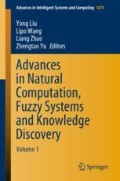Abstract
Medical images play an important role in clinics. Machine learning has been widely used in the fields of computer vision and pattern recognition and computer-aided diagnosis with medical images become an active research topic. Efficient representation of the medical images or effective extraction of discriminative features from CT images is one of crucial steps in computer-aided diagnosis. Principal component analysis (PCA) is a subspace learning method and is widely used for efficient representation of data. The limitation of PCA is that a multi-dimensional data (e.g. an image or a video image) should be unfolded into a vector resulting in loss of spatial and spatial-temporal relationship of the data. In this paper, we proposed an efficient representation of multi-phase CT images based on a tensor-based subspace learning method known as generalized N-dimensional principal component analysis (GND-PCA). In the proposed method, the multi-phase CT image is treated a tensor without vector-unfolding for subspace learning. The core tensor obtained by GND-PCA is used as temporal and spatial features for focal liver lesion classification. Experiments show that in the case of fewer samples, GND-PCA achieved better results than conventional PCA and 2D-PCA, which is an extension of PCA.
J. Song and S. Zhu—The first two authors contributed equally to this paper.
Access this chapter
Tax calculation will be finalised at checkout
Purchases are for personal use only
References
Ryerson, A.B., et al.: Annual report to the nation on the status of cancer, 1975–2012, featuring the increasing incidence of liver cancer. Cancer 122(9), 1312–1337 (2016)
Roy, S., et al.: Three-dimensional spatiotemporal features for fast content-based retrieval of focal liver lesions. IEEE Trans. Biomed. Eng. 61(11), 2768–2778 (2014)
Yu, M., et al.: Extraction of lesion-partitioned features and retrieval of contrast-enhanced liver images. Comput. Math. Meth. Med. 2012, 12 (2012)
Yang, W., et al.: Content-based retrieval of focal liver lesions using bag-of-visual-words representations of single-and multiphase contrast-enhanced CT images. J. Digit. Imaging 25(6), 708–719 (2012)
Diamant, I., et al.: Improved patch-based automated liver lesion classification by separate analysis of the interior and boundary regions. IEEE J. Biomed. Health Inform. 20(6), 1585–1594 (2016)
Xu, Y., et al.: Bag of temporal co-occurrence words for retrieval of focal liver lesions using 3D multiphase contrast-enhanced CT images. In: Proceedings of 23rd International Conference on Pattern Recognition, ICPR 2016, pp. 2283–2288 (2016)
Wang, J., et al.: Sparse codebook model of local structures for retrieval of focal liver lesions using multiphase medical images. Int. J. Biomed. Imaging 2017, 13 (2017)
Xu, Y., et al.: Texture-specific bag of visual words model and spatial cone matching-based method for the retrieval of focal liver lesions using multiphase contrast-enhanced CT images. Int. J. Comput. Assist. Radiol. Surg. 13(1), 151–164 (2018)
Frid-Adar, M., Diamant, I., Klang, E., Amitai, M., Goldberger, J., Greenspan, H.: Modeling the intra-class variability for liver lesion detection using a multi-class patch-based CNN. In: Wu, G., Munsell, B.C., Zhan, Y., Bai, W., Sanroma, G., Coupé, P. (eds.) Patch-MI 2017. LNCS, vol. 10530, pp. 129–137. Springer, Cham (2017). https://doi.org/10.1007/978-3-31967434-6_15
Yasaka, K., et al.: Deep learning with convolutional neural network for differentiation of liver masses at dynamic contrast-enhanced CT: a preliminary study. Radiology 286(3), 887–896 (2017)
Liang, D., et al.: Residual convolutional neural networks with global and local pathways for classification of focal liver lesions. In: Geng, X., Kang, B.H. (eds.) PRICAI 2018: Trends in Artificial Intelligence, PRICAI 2018, Nanjin, China, 28–31 August 2018. Lecture Notes in Artificial Intelligence, vol. 11012, pp. 617–628. Springer (2018)
Liang, D., et al.: Combining Convolutional and recurrent neural networks for classification of focal liver lesions in multi-phase CT images. In: Frangi, A., Schnabel, J., Davatzikos, C., Alberola-López, C., Fichtinger, G. (eds.) Medical Image Computing and Computer Assisted Intervention – MICCAI 2018. Lecture Notes in Computer Science, LNCS, vol. 11071, pp. 666–675, Springer (2018)
Xu, R., Chen, Y.-W.: Generalized N-dimensional principal component analysis (GND-PCA) and its application on construction of statistical appearance models for medical volumes with fewer samples. Neurocomputing 72, 2276–2287 (2009)
Turk, M., Pentland, A.: Eigenfaces for recognition. J. Cogn. Neurosci. 3, 71–86 (1991)
Yang, J., et al.: Two-dimensional PCA: a new approach to appearance-based face representation and recognition. IEEE Trans. Pattern Anal. Mach. Intell. 26, 131–137 (2004)
Acknowledgement
This research was supported in part by the Grant-in Aid for Scientific Research from the Japanese Ministry for Education, Science, Culture and Sports (MEXT) under the Grant No. 18H03267, and No. 18H04747, and in part by Zhejiang Lab Program under the Grant No. 2018DG0ZX01.
Author information
Authors and Affiliations
Corresponding author
Editor information
Editors and Affiliations
Rights and permissions
Copyright information
© 2020 Springer Nature Switzerland AG
About this paper
Cite this paper
Song, J., Zhu, S., Lin, L., Hu, H., Chen, YW. (2020). Tensor-Based Subspace Learning for Classification of Focal Liver Lesions in Multi-phase CT Images. In: Liu, Y., Wang, L., Zhao, L., Yu, Z. (eds) Advances in Natural Computation, Fuzzy Systems and Knowledge Discovery. ICNC-FSKD 2019. Advances in Intelligent Systems and Computing, vol 1074. Springer, Cham. https://doi.org/10.1007/978-3-030-32456-8_66
Download citation
DOI: https://doi.org/10.1007/978-3-030-32456-8_66
Published:
Publisher Name: Springer, Cham
Print ISBN: 978-3-030-32455-1
Online ISBN: 978-3-030-32456-8
eBook Packages: Intelligent Technologies and RoboticsIntelligent Technologies and Robotics (R0)

